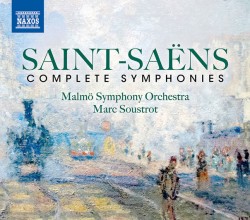 Saint-Saëns – Complete Symphonies
Saint-Saëns – Complete Symphonies
Malmo Symphony Orchestra; Marc Soustrot
Naxos 8.503301 (naxos.com/CatalogueDetail/?id=8.503301)
Anyone trying to dismiss Camille Saint-Saëns as a minor composer and pushing him to the sidelines would be surprised hearing this already much praised new set of his complete symphonic output. The conductor is Marc Soustrot a highly accomplished French musician, specialist in French Romanticism and he puts his heart and soul into these performances. The Swedish orchestra follows him every inch of the way and with HD sound this set becomes a clear first choice.
I have always been fond of this tremendously talented French composer/pianist who had a long productive life from the mid 19th into early 20th century. The fondness I mentioned originated when my father took me to the first concert of my life at age seven right after the War. The program started with Danse Macabre and my dad explained to me the story of the ghosts and the skeletons, the midnight bells, the devil’s violin solo and the final rooster call.... Wow! I also became quite addicted to the Carnival of the Animals.
Saint-Saëns was a child prodigy and wrote a symphony when he was 15 but was cautious like Brahms and didn’t give it a number. He called it Symphony in A Major and it is a tribute to Mozart. It’s a charming work, quite expertly written; it is interesting that he used the same four notes (C, D, F, E) Mozart used to build the last magnificent contrapuntal movement of the Jupiter Symphony.
His numbered symphonies began two years later with No.1 in E-flat Major and I found it thoroughly enjoyable. It has a gorgeous second movement (March, Scherzo) with a melody one wants to sing along with while the Adagio has a long, sustained clarinet solo, so enchanting I wished it would never end. To top it, the Finale even has a military band that sounds like a Napoleonic march. This is French Empire music. In fact, the symphonies were admired by Berlioz and Gounod.
After a competition entry symphony, again without a number, Urbs Roma (now almost never played) the boy keeps honing his skills with the Second Symphony, already a mature work with an energetic, syncopated fugue and an elegant presto, a somewhat Italianate finale where the influence of Mendelssohn is noticeable.
However, the best is yet to come.
It is so interesting that in many a composer’s career there is a sudden qualitative leap, a divine inspiration that produces a work so superior to and unlike what has been written before. Such a work is the magnificent Third Symphony in C Minor. It’s a masterpiece of the first order, highly innovative with an organ and two pianos added. Much recorded by the greats, it’s always a highlight in the concert hall. There is a cyclical theme (à la Liszt) which underlines the structure, is capable of many transformations and keeps everything together. The first movement is exciting with the cyclical theme in restless, constant motion while the second movement simply glows with religious piety with the wonderful support by the organ. The tempo picks up in the incisive Scherzo where the two pianos are added. After a suspenseful Transition an explosion ff of the organ is very effective. The symphony ends triumphantly with a final accelerando and a long-reverberated organ note.
As an added bonus, this fascinating set also contains the four inspired and atmospheric symphonic poems, including my old friend the Danse Macabre and three others all inspired by Greek mythology.



